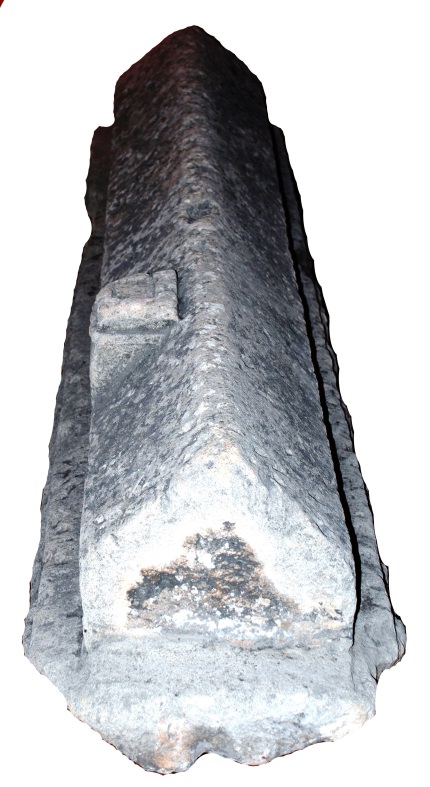Monolithic covering of a tomb
The digs in the final decades of 19th century, that devastated the Punic necropolises in Tharros, brought to light some details of the tomb covers.
While the tombs dug out of the earth normally had a simple stone or slab cover, a small number of them were covered by a large, dual sloping monolithic block, with a small altar on one side, with a concave upper part (figs. 1-2).

Fig. 1 - Monolithic covering of Punic tomb (5th century B.C.) (Oristano, Antiquarium Arborense) (photo from Unicity S.p.A.)

Fig. 2 - Monolithic covering of Punic tomb (5th century B.C.) (Oristano, Antiquarium Arborense) (photo from Unicity S.p.A.)
This is a small imitation of the top part of the “stelae-altars”, that are often found and a feature of the Tharros tophet. This was probably a place to burn perfumed substances during rituals in memory of the deceased.
This tomb covering is repeated on a small number of tombs in Tharros necropolises, which are all almost identical.

Fig. 3 - Monolithic covering of Punic tomb (5th century B.C.) (Oristano, Antiquarium Arborense) (photo from Unicity S.p.A.)

Fig. 4 - Monolithic covering of Punic tomb (5th century B.C.) (Oristano, Antiquarium Arborense) (photo from Unicity S.p.A.)
Bibliografia
- S. MOSCATI, Le officine di Tharros (Studia Punica 2), Roma 1987.
- S. MOSCATI, M.L. UBERTI, Scavi al tophet di Tharros. I monumenti lapidei, Roma 1985.
- G. TORE, Cippi, altarini e stele funerarie nella Sardegna fenicio-punica (nota preliminare), in Riti funerari e di olocausto nella Sardegna fenicia e punica (=Quaderni della Soprintendenza Archeologica di Cagliari e Oristano 6/1989, supplemento), pp. 109-122.

 VR
VR